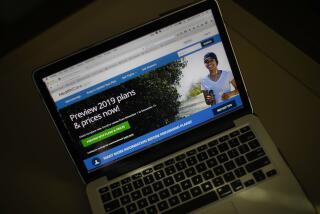Change of Heart : Health: Risk assessment program identifies candidates for cardiac disease and teaches them how to prevent it.
- Share via
When cardiologist Irving Loh talks, people tend to listen.
“One and a half million people each year have a heart attack. A half-million die,” he said. “Forty percent may have no symptoms whatsoever until the first event, which could be dropping dead.”
This statistical bombshell is dropped about once every three weeks. It’s his way of starting off lectures designed to educate clients about the cardiovascular system and how to avoid heart attacks.
The lecture is one phase of the heart risk assessment program offered by the Ventura Heart Institute at Los Robles Regional Medical Center. Loh’s clients, who total about 12 at each lecture, clearly have a vested interest in hearing what he has to say.
Members of the Ventura Fire Department and employees from Rockwell International and General Motors have been through the program in groups sponsored by their employers. Almost everyone else participating are individuals at risk of having a heart attack early in life, some of whom have been referred by personal physicians and others who have come in of their own volition.
The 2-year-old risk assessment program, run by Loh and a staff of five, includes a blood test, a 1 1/2-hour lecture on cardiovascular health and a treadmill stress test, for a total cost of $325.
The result is a computer evaluation of the patient’s chance of having a heart attack within eight years as compared to other people of the same sex and age.
“The average patient comes in because he or she is concerned about his or her cardiac status,” said Loh.
“I don’t provide follow-ups for them. They all have their own doctors. I make recommendations to their doctors and tell them what I think should be done.”
According to the latest American Heart Assn. figures, nearly 25% of all Americans suffer some form of cardiovascular disease--coronary heart disease, stroke, high blood pressure, atherosclerosis, rheumatic heart disease or congenital heart disease.
Loh includes such attention-grabbing statistics in his lecture, the component, experts say, that separates Loh’s program from other programs throughout the state.
Loh tells patients about coronary artery disease, blood pressure and cholesterol.
He also discusses controllable risk factors, such as diet and exercise, and uncontrollable risk factors, such as diabetes, associated with cardiovascular diseases.
Most risk assessment programs do not go into such detail, simply because “it takes too much time,” said Dr. Alan Rider, president of the California affiliate of the American Heart Assn. “A lot of commercial establishments will give you a printout and say, ‘This is your problem, and this is how you should work on it,’ and a lot of patients really don’t understand what the problem is.”
As a cardiologist with a private practice of his own, Rider said that few physicians can take the time to discuss patient’s problems to such an extent.
“I can’t take an hour and a half to sit with a patient and talk about what risk factors mean,” he said. “I’ve got to do it in 15 minutes and presumably not as effectively.”
Neal Kohatsu, chief of the Epidemiology and Disease Prevention section of the state Department of Health Services, said that though individual elements of the Loh program are not unique, the time given to patients is.
There are similar programs at UCLA, the University of San Francisco, USC and Stanford, “but no one spends that much time in special classes except something akin to the Pritikin Program,” he said.
Loh’s lecture helps clients understand two other phases of the overall risk assessment--the blood workup and the treadmill stress test.
The blood test shows the patient’s cholesterol levels and looks for other factors that could contribute to cardiac disease, such as diabetes and liver malfunctions.
The treadmill test, administered while the patient is hooked up to an EKG machine, monitors the patient’s heart rhythm and blood pressure.
Combining the results of both tests provides cardiologists with clues to a patient’s predisposition to cardiovascular disease. The average client goes home with a better understanding of his or her health and the knowledge needed to work on preventing a heart attack.
The rare client, like 45-year-old Nancy Pretlak of Thousand Oaks, is on the operating table in less than a week.
“I did the treadmill test on Wednesday. On Monday, I was back in the hospital for open heart surgery, a triple bypass,” she said. “There was no discomfort, no pain, no warning, nothing.”
Thus far, 611 people have gone through the program at Los Robles--not a significant number when compared to the millions of Americans needing both heart risk assessment and follow-up, said the American Heart Assn.’s Rider.
“The problem with this approach is that you’re talking about nine people at a time who can afford $325,” Rider said. “It’s a wonderful opportunity for people who can take advantage of it, but it doesn’t address the larger issue of the thousands of people who need to address and correct their risk factors.”
Loh agreed that the program is costly for those on limited incomes who aren’t insured or who haven’t had a definite diagnosis, the insurance companies’ criterion for payment.
On the other hand, he said, no one practicing preventive medicine is making a profit, and doctors and hospitals have to begin somewhere.
“Health care in the United States costs $600 billion per year,” he said.
“If you prevent some of the problems in the first place, you can make a significant difference.”






